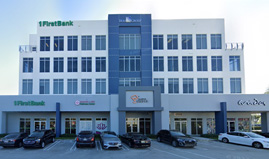Instability/Dislocation
Shoulder Instability
Shoulder instability is a chronic condition that causes frequent dislocations of the shoulder joint.
Causes
A dislocation occurs when the end of the humerus (the ball portion) partially or completely dislocates from the glenoid (the socket portion) of the shoulder. A partial dislocation is referred to as a subluxation whereas a complete separation is referred to as a dislocation.
Risk Factors
The risk factors that increase the chances of developing shoulder instability include:
- Injury or trauma to the shoulder
- Falling on an outstretched hand
- Repetitive overhead sports such as baseball, swimming, volleyball, or weightlifting
- Loose shoulder ligaments or an enlarged capsule
Symptoms
The common symptoms of shoulder instability include pain with certain movements of the shoulder; popping or grinding sound may be heard or felt, swelling and bruising of the shoulder may be seen immediately following subluxation or dislocation. Visible deformity and loss of function of the shoulder occurs after subluxation or sensation changes such as numbness or even partial paralysis can occur below the dislocation because of pressure on nerves and blood vessels.
Conservative Treatment
The goal of conservative treatment for shoulder instability is to restore stability, strength, and full range of motion. Conservative treatment measures may include the following:
- Closed Reduction: Following a dislocation, your surgeon can often manipulate the shoulder joint, usually under anesthesia, realigning it into proper position. Surgery may be necessary to restore normal function depending on your situation
- Medications: Over the counter pain medications and NSAID’s can help reduce the pain and swelling. Steroidal injections may also be administered to decrease swelling
- Rest: Rest the injured shoulder and avoid activities that require overhead motion. A sling may be worn for 2 weeks to facilitate healing
- Ice: Ice packs should be applied to the affected area for 20 minutes every hour
Surgery
When the conservative treatment options fail to relieve shoulder instability, your surgeon may recommend shoulder stabilization surgery. Shoulder stabilization surgery is done to improve stability and function to the shoulder joint and prevent recurrent dislocations. It can be performed arthroscopically, depending on your situation, with much smaller incisions. Arthroscopy is a surgical procedure in which an arthroscope, a small flexible tube with a light and video camera at the end, is inserted into a joint to evaluate and treat of the condition. The benefits of arthroscopy compared to the alternative, open shoulder surgery are smaller incisions, minimal soft tissue trauma, less pain leading to faster recovery.
Dislocated Shoulder
Playing more overhead sports activities and repeated use of shoulder at workplace may lead to sliding of the upper arm bone, the ball portion, from the glenoid–the socket portion of the shoulder. The dislocation might be a partial dislocation (subluxation) or a complete dislocation causing pain and shoulder joint instability. Shoulder joint often dislocates in the forward direction (anterior instability) and it may also dislocate in backward or downward direction.
Most common symptoms of shoulder dislocation are pain and shoulder joint instability. Other symptoms such as swelling, numbness and bruising may occur. At times, it may cause tear in the ligaments or tendons of the shoulder and nerve damage. Your doctor will examine your shoulder and may order an X-ray to confirm the diagnosis.
The condition is treated by a process called closed reduction which involves placing the ball of the upper arm back into the socket. Following this, the shoulder will be immobilized using a sling for several weeks. Ice may be applied over the area for 3-4 times a day. Rehabilitation exercises may be started to restore range of motion, once the pain and swelling decrease.













